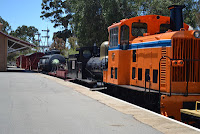So as has been previously mentioned here, I have been converting my rolling stock to kadee couplers for improved ease of use over the various U.K. toy outline couplers my stock came with. Also for compatibility between my OO scale U.K. stock and my HO scale U.S.A. stock. Of course, this all changes if I ever move to the P4 (Protofour) standard for my U.K. stock and start running them on correctly gauged and scaled track, but that's another story.
The easiest Kadee conversion was my Bachmann pannier with its NEM socket for couplings, it literally made it plug and play, though I did follow some internet advice and get each of the NEM Kadee sizes so I could try for lengths. This was particularly helpful as the 4 sizes are not equally bigger/smaller than their siblings.
Most wagons were a straight forward drill and tap to fit a draft gear box and heights so far have not needed to be altered. The bogie coach was a bit tricky as it was a case of sawing the original metal tension lock couplings off the bogies and then affixing the draft gear boxes to the bogies (Yes in a perfect world the couplers would have been fixed to the coach body but the scale 60' coach on even my largest 23" real life radius curve has too much overhang and would have needed some sort of tricky setup for the couplers to work)
Bachmann Percy took some filing of his buffer beams to fit the draft boxes at the correct height and were glued on rather than fastened by screws which would have requiring drilling and tapping of Percy's running boards. Hornby Thomas was a glue job also, after cutting into the frames to accommodate the draft gear boxes at either end.
My last Kadee conversion project (at least for a while, I hope) was to be the Hornby 14xx and sadly this is where I should have searched the interwebs first. I set off converting with draft gear box accommodation in mind as it had worked fairly well with everything else, right? In this case though I was cutting into a solid metal frame/chassis. When Dapol picked up the molds of this model from Airfix, they improved the electrical pickup mechanism so that it works better for longer than the complicated Airfix wiper mechanism (especially with the small springs that soon stopped springing, among other issues). The one advantage of the Airfix version was that it made replacing the keeper plate less tricky than the new Dapol wipers that Hornby carried on the tradition of. Damaging the wipers or the insulating plastic or both was my chief concern, and I did break some wipers and insulation on my Hornby model.
So after irrevocably cutting out solid metal from the frame/chassis and gluing on the draft gear boxes, I had do some repairs to the wiper mechanism: one wire to the motor had become detached at the keeper plate end, one wiper had snapped off and many wipers had lost their insulation. Soldering was the best bet for fixing the wire and wiper, while gluing thin styrene to the wipers was the fix for those that had become uninsulated. Given my usual results in soldering I was apprehensive about taking an iron to a piece that was so vital to the running of the loco. I am happy to say that with a clean iron, and the job set up gently but firmly in a vice, things went fairly well. At the end of the day, the locomotive now runs again AND has Kadee couplers, primary objectives achieved.
The bad: all the cutting was unnecessary, if only I had thought outside the (draft gear) box and/or done deep enough searching on the interwebs.
The good: 1) I am not the only one to have trouble with the keeper plate, 2) I seem to have become better at soldering and 3) I now have mostly kadee equipped rolling stock!
The immediate future of my 14xx involves some plastic friendly grease to quiet the worm & gear. Then the Mainly Trains body detail kit and eventually replacing the wheels with either some Markit Driving Wheels (BRw14xx) or if I can be patient enough and afford it, the very fine Ultrascale complete set (including metal drive gear, though the mechanism has an intermediary plastic step gear down still). One day of course the whole chassis is a contender for either a Comet or High Level replacement, with DCC sound of course, but that tale has yet to be told...










